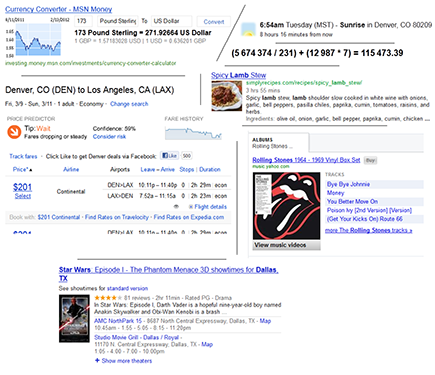Figure 2-1: The primary search results are from the organic and PPC indexes.
Chapter 2
Search Results, Deconstructed
In This Chapter
![]() Deciphering the construction of the search-results page
Deciphering the construction of the search-results page
![]() Discovering organic and PPC results
Discovering organic and PPC results
![]() Understanding the importance of Local
Understanding the importance of Local
![]() Finding out about shopping, video, images, movies, recipes, and more
Finding out about shopping, video, images, movies, recipes, and more
Before I jump into the nitty-gritty of how to get your site ranked high in the search engines, you should look at what the term search results really means. All too often, people think of search results as a single thing, whereas, in fact, it’s a combination of different things, and until you understand what those different things really are, you can’t see the entire picture.
Different search terms will produce different search results. The results will always include information from the organic index, but whether or not results are included from the Local index, the Shopping index, the PPC index, and so on depends on the type of search made. Search for pizza, for instance, and you’ll find information from the Local index, search for first indian war of independence and you won’t. The search engines are trying to provide you with the best results, so they analyze the search terms to figure out what you’re likely to be looking for. Are you looking for a local business? News? A video or image, perhaps?
The search engine results pages (SERPs) produced by major search engines seem to get more complicated year by year, and it’s worth understanding where the information on the results pages actually comes from, which is what I look at in this chapter.
The Big Two: Organic and PPC
Search results are mostly dominated by two particular indexes: the organic or natural search results, and the PPC (Pay Per Click) search results. Take a look at Figure 2-1; I’ve marked the two areas.
The organic-results index is created by searchbots. For instance, Google uses something called a googlebot to retrieve pages. It’s common to talk about searchbots as if somehow they wander around the Web, moving from page to page through links between the pages, collecting the pages, and sending them back to home base to be analyzed and indexed. Of course what’s really going on is that bots are programs, running on the search engine’s servers, that send requests to Web servers asking for pages — just as your browser does when you click a link. The organic index is, in effect, the oldest collection of search-result data. The first thing that the first search engines did was to use bots to index Web pages.
By the way, the search results typically put ten results from the organic index into the search-results page, though, as you see later in this chapter, those results are often interspersed with other types of search results. (In some cases, in particular when adding local results to the page, the search engines may display a smaller number of organic-search results, perhaps seven or eight.)
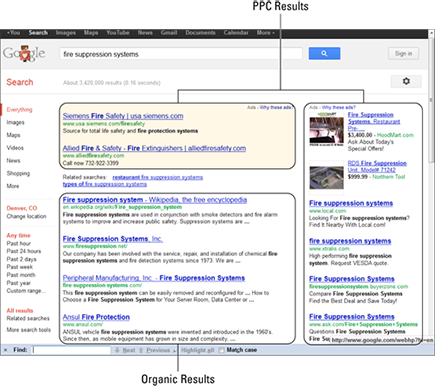
Later, in 2008, ads began appearing in search results. Today, the three major search engines all display PPC ads, ads that cost the advertiser nothing until someone clicks the ad, at which point the advertiser is charged instantly (thus, “pay per click”).
PPC ads are typically placed at the top of the search results (three or four results, though sometimes Google omits the top ads) and in a column to the right of the main search results. It’s often unclear where the PPC ads end and the organic results begin — the three major search engines put a colored background under the ads at the top and a label that says Ads or Sponsored Results, but on many screens, the color is sometimes not noticeable (particularly in Google’s ads these days), and the label is often missed among the general page clutter. Thus many users don’t realize the distinction between organic results and PPC ads.
On the other hand, among people who do understand the distinction, there are various schools of thought: Some users never click the ads, some always click the ads and ignore the organic results, while others realize that the ads provide really good results for some searches and not-so-good results for others.
When people talk about search engine optimization, they’re typically talking about the organic search results. When you optimize pages, for instance (see Chapters 3, 7, and 8), you’re typically doing so in order to rank well in the organic index. In this book, though, I discuss other indexes, in particular the Local and Shopping indexes (see the next two sections). As for PPC — that’s an advertising mechanism, a very different subject not covered in this book.
Looking at Local Results
There’s a relatively new type of result that has become incredibly important, with a huge presence in many search-results pages. Search Yahoo!, for instance, for the term personal injury attorney, and you may see something like Figure 2-2. These Local results can take up a lot of space, in particular in Google and Yahoo!, and thus are an important consideration for businesses that serve a particular geographic area. I look at this subject in Chapter 11.
Figure 2-2: Local results can often take up a significant part of the search-results page (here shown in Yahoo!).
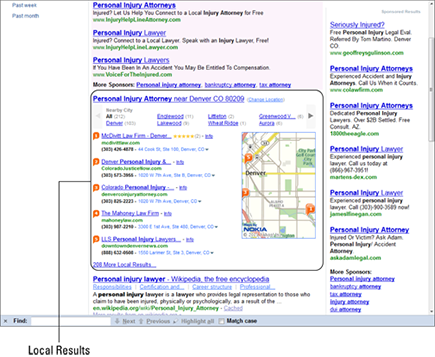
Checking Out Shopping Results
It’s often not hard for the search engines to figure out when someone is quite likely searching for a product he may be interested in buying. If someone searches for shoes, it’s quite likely he’s interested in buying a pair, either offline (that’s where the Local results come in) or online (that’s where the Shopping results come in). On the other hand, if someone searches on shoe manufacturing victorian england, it’s unlikely that he’s in the market for a pair.
The major search engines all maintain product indexes, totally separate from the organic or even the PPC indexes. (Chapter 14 explains how to get your products into those indexes.)
When a search engine figures you may be looking for product information, it inserts product results — typically with images — into the search-results page (see Figure 2-3). Clicking the Shopping search results leads into the search engine’s shopping area, where the searcher can find more information about these, and other, products.
Figure 2-3: Shopping results are typically embedded into the other results, but lead to more extensive information.
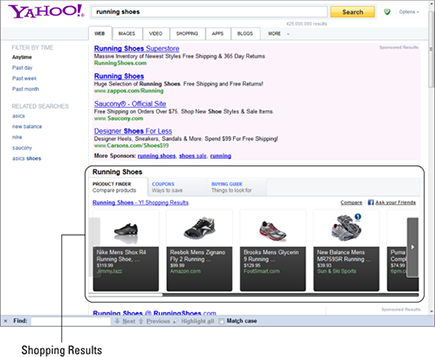
Staying Current with News Results
Another significant search-result component is the News results. If the search engines think News results might be useful to you, based on your search — search for obama or just about any country name, for instance — then you’ll see News results embedded into the results page.
Again, these are from a completely different source; in fact, publishers have to apply to be included in the News results, shown in Figure 2-4. (Google has an established process and takes many sites; see http://support.google.com/news/publisher. Yahoo! and Bing are far more restrictive.)
Figure 2-4: News results will appear for appropriate searches. (All these results are pulled from the news index.)
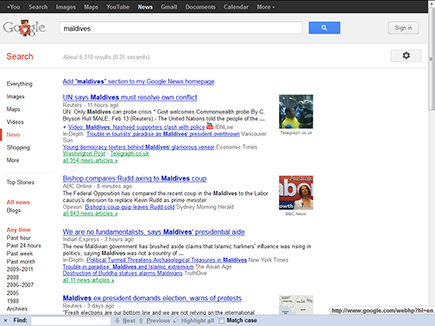
Viewing Video and Image Results
You’ve almost certainly seen video and image results in the search engines (see Figure 2-5). All three of the major search engines index Youtube.com (it’s owned by Google). But they index other sites, too, such as Vimeo.com, Vevo.com, and Metcafe.com. If you want to try getting your videos into the search results, see Chapter 19.
Figure 2-5: Videos are often dropped into the search results.
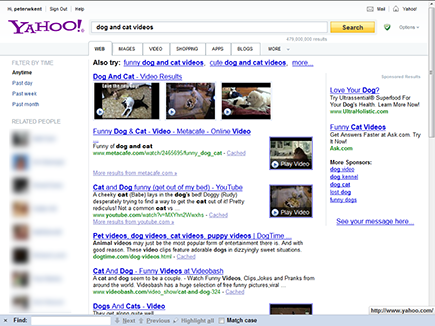
Getting Friendly with Social Results
In Chapter 18, you find out about the social networks and how to use them to your advantage. Currently the three major search engines incorporate social-network results into the organic index; in other words, they index social-network sites just like any other site.
There was a time when Google was indexing Twitter tweets and providing them in a little scrolling box embedded within the search results. Google no longer does that, at least at the time of writing. Perhaps the big social-networking news, though, as far as Google goes, is Google+, Google’s answer to Facebook. Have you noticed small author photos associated with search results, often from blogs? (See Figure 2-6.) These little pictures are coming from Google+ accounts. (I explain how in Chapter 18.) Google is also personalizing your search results based on your Google+ relationships. If you’re searching Google while logged into your Google account, you may see personal results from your Google+ friends at the top of the page.
Figure 2-6: You can use Google+ accounts to associate pictures with your publications.
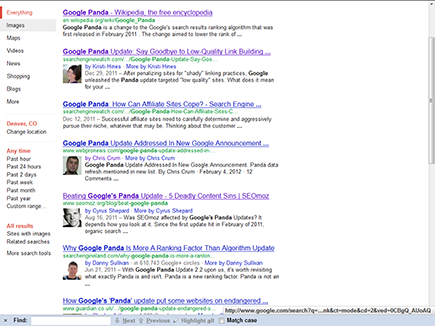
Collecting Bits n’ Pieces
Finally, the search engines often embed little “bits and pieces” into the search results, data totally separate from these other indexes. For instance, search for sunrise 80209 in Google, and right at the top of the search results you’ll see the time of the next sunrise (see Figure 2-7). Try searching for 173 pounds in usd, in any of the three major search engines, and you’ll see the current exchange rate, British pounds to U.S. dollars.
All three also have calculators (try (5674374 / 231) + (12987 * 7), for instance). Looking for a flight? Or movie? Google and Bing will both provide flights, while Google will give you movie times. (Try, say, fly denver to los angeles and star wars dallas tx.) Cooking tonight? Search for lamb on Google, then click the Recipes link that appears in the left column, and that’s just what you’ll get. Search Yahoo! for a musician or band, and you’ll get music results. (Some of these results are rich snippets, information that you can feed to the search engines if you know how to tag the data; see Chapter 7 for information.)
You may want to dig around sometime in your favorite search engine — try all the links and see where they go and read the Help pages to see what fancy tools are available. You may be amazed at what you find.
Figure 2-7: The search engines provide all sorts of weird and wonderful results.
